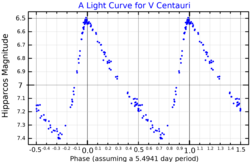
A | B | C | D | E | F | G | H | CH | I | J | K | L | M | N | O | P | Q | R | S | T | U | V | W | X | Y | Z | 0 | 1 | 2 | 3 | 4 | 5 | 6 | 7 | 8 | 9
| Observation data Epoch J2000 Equinox J2000 | |
|---|---|
| Constellation | Centaurus |
| Right ascension | 14h 32m 33.0833s[2] |
| Declination | −56° 53′ 15.774″[2] |
| Apparent magnitude (V) | 6.42 - 7.22[3] |
| Characteristics | |
| Spectral type | F5 Ib/II[4] |
| B−V color index | 0.87[5] |
| Variable type | Classical Cepheid[3] |
| Astrometry | |
| Radial velocity (Rv) | −18.90 ± 1.4[6] km/s |
| Proper motion (μ) | RA: −6.697[2] mas/yr Dec.: −7.068[2] mas/yr |
| Parallax (π) | 1.3898 ± 0.0221 mas[2] |
| Distance | 2,350 ± 40 ly (720 ± 10 pc) |
| Details | |
| Mass | 4.3[7] M☉ |
| Radius | 40[2] R☉ |
| Luminosity | 1,657[8] L☉ |
| Surface gravity (log g) | 1.89[2] cgs |
| Temperature | 5,500[8] K |
| Metallicity | +0.12[9] dex |
| Age | 103[10] Myr |
| Other designations | |
| Database references | |
| SIMBAD | data |
V Centauri (V Cen) is a Classical Cepheid variable, a type of variable star, in the constellation Centaurus. It is approximately 2,350 light-years (720 parsecs) away based on parallax.
V Centauri varies regularly between visual magnitudes 4.2 and 7.2 every 5.5 days. It is classified as a Cepheid variable on the basis of its light variations, with the brightness increase from minimum to maximum taking only a third of the time of the decrease from maximum to minimum. Cepheids are pulsating variable stars and V Centauri expands and contracts over its pulsation cycle as well as changing temperature.[3]
According to the South African Astronomical Observatory, the chemical composition was derived as being high in sodium (Na) and aluminium (Al) and low in magnesium (Mg).[11] Following a normal composition for a Cepheid star, V Cen does not have any unusual characteristics. V Centauri's composition was observed alongside six other Classical Cepheid variable stars with the support of Russian, Chilean, and Ukrainian observatories.[11]
References
- ^ "Hipparcos Tools Interactive Data Access". Hipparcos. ESA. Retrieved 8 December 2021.
- ^ a b c d e f g Vallenari, A.; et al. (Gaia collaboration) (2023). "Gaia Data Release 3. Summary of the content and survey properties". Astronomy and Astrophysics. 674: A1. arXiv:2208.00211. Bibcode:2023A&A...674A...1G. doi:10.1051/0004-6361/202243940. S2CID 244398875. Gaia DR3 record for this source at VizieR.
- ^ a b c Samus, N. N.; Durlevich, O. V.; et al. (2009). "VizieR Online Data Catalog: General Catalogue of Variable Stars (Samus+ 2007-2013)". VizieR On-line Data Catalog: B/GCVS. Originally Published in: 2009yCat....102025S. 1: B/gcvs. Bibcode:2009yCat....102025S.
- ^ Houk, N.; Cowley, A. P. (1975). "University of Michigan Catalogue of two-dimensional spectral types for the HD stars. Volume I. Declinations -90°.0 to -53°.0". Michigan Catalogue of Two-dimensional Spectral Types for the HD Stars. 1. Bibcode:1975mcts.book.....H.
- ^ a b "V* V Cen". SIMBAD. Centre de données astronomiques de Strasbourg.
- ^ Gontcharov, G. A. (2006). "Pulkovo Compilation of Radial Velocities for 35 495 Hipparcos stars in a common system". Astronomy Letters. 32 (11): 759–771. arXiv:1606.08053. Bibcode:2006AstL...32..759G. doi:10.1134/S1063773706110065. S2CID 119231169.
- ^ Marconi, Marcella; et al. (July 2020). "Predicted Masses of Galactic Cepheids in the Gaia Data Release 2". The Astrophysical Journal Letters. 898 (1): L7. arXiv:2006.16610. Bibcode:2020ApJ...898L...7M. doi:10.3847/2041-8213/aba12b. S2CID 220265392. L7.
- ^ a b Groenewegen, M. A. T. (2020). "Analysing the spectral energy distributions of Galactic classical Cepheids". Astronomy and Astrophysics. 635: A33. arXiv:2002.02186. Bibcode:2020A&A...635A..33G. doi:10.1051/0004-6361/201937060. S2CID 211043995.
- ^ Ripepi, V.; Catanzaro, G.; Clementini, G.; De Somma, G.; Drimmel, R.; Leccia, S.; Marconi, M.; Molinaro, R.; Musella, I.; Poggio, E. (2022). "Classical Cepheid period-Wesenheit-metallicity relation in the Gaia bands". Astronomy and Astrophysics. 659: A167. arXiv:2201.01126. Bibcode:2022A&A...659A.167R. doi:10.1051/0004-6361/202142649. S2CID 245668845.
- ^ Skowron, D. M.; Skowron, J.; Mróz, P.; Udalski, A.; Pietrukowicz, P.; Soszyński, I.; Szymański, M. K.; Poleski, R.; Kozłowski, S.; Ulaczyk, K.; Rybicki, K.; Iwanek, P.; . Wrona, M.; Gromadzki, M. (2019). "Mapping the Northern Galactic Disk Warp with Classical Cepheids". Acta Astronomica. 69 (4): 305. arXiv:1912.11142. Bibcode:2019AcA....69..305S. doi:10.32023/0001-5237/69.4.1. S2CID 209460868.
- ^ a b Usenko, I. A.; Kniazev, A. Yu; Berdnikov, L. N.; Kravtsov, V. V.; Fokin, A. B. (2013-07-01). "Spectroscopic studies of southern-hemisphere Cepheids: Six objects in Centaurus (V Cen, V737 Cen) and Sagittarius (BB Sgr, W Sgr, X Sgr, Y Sgr)". Astronomy Letters. 39 (7): 432–445. Bibcode:2013AstL...39..432U. doi:10.1134/S1063773713070074. ISSN 1063-7737. S2CID 121213614.
Text je dostupný za podmienok Creative Commons Attribution/Share-Alike License 3.0 Unported; prípadne za ďalších podmienok. Podrobnejšie informácie nájdete na stránke Podmienky použitia.
Antropológia
Aplikované vedy
Bibliometria
Dejiny vedy
Encyklopédie
Filozofia vedy
Forenzné vedy
Humanitné vedy
Knižničná veda
Kryogenika
Kryptológia
Kulturológia
Literárna veda
Medzidisciplinárne oblasti
Metódy kvantitatívnej analýzy
Metavedy
Metodika
Text je dostupný za podmienok Creative
Commons Attribution/Share-Alike License 3.0 Unported; prípadne za ďalších
podmienok.
Podrobnejšie informácie nájdete na stránke Podmienky
použitia.
www.astronomia.sk | www.biologia.sk | www.botanika.sk | www.dejiny.sk | www.economy.sk | www.elektrotechnika.sk | www.estetika.sk | www.farmakologia.sk | www.filozofia.sk | Fyzika | www.futurologia.sk | www.genetika.sk | www.chemia.sk | www.lingvistika.sk | www.politologia.sk | www.psychologia.sk | www.sexuologia.sk | www.sociologia.sk | www.veda.sk I www.zoologia.sk

